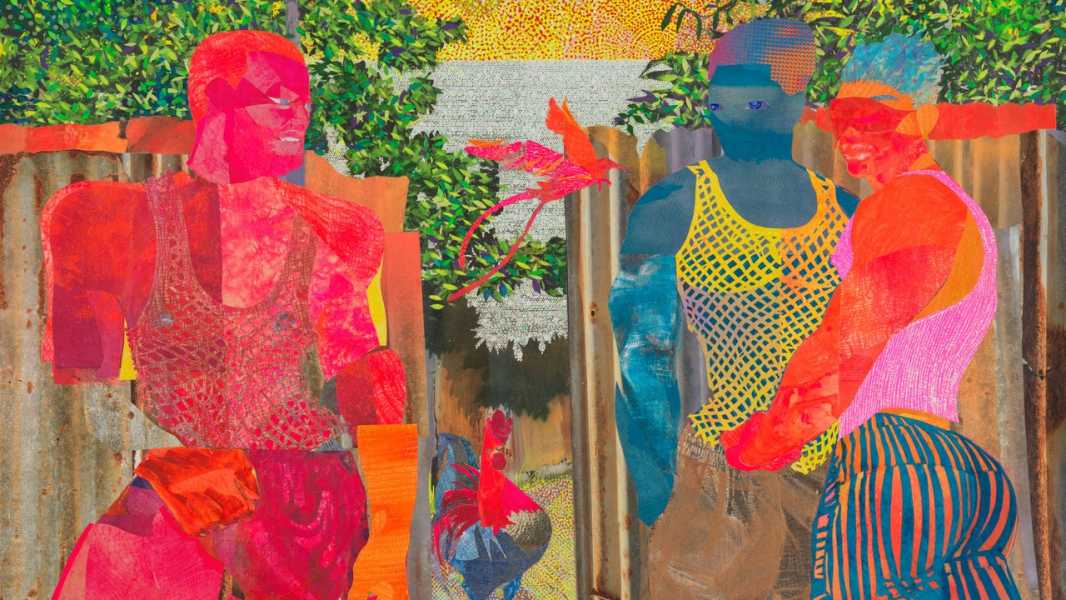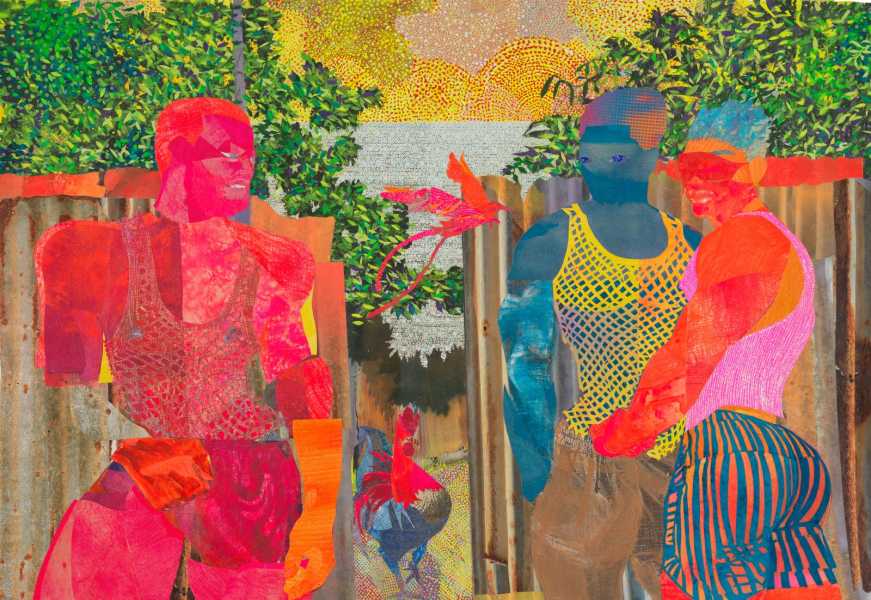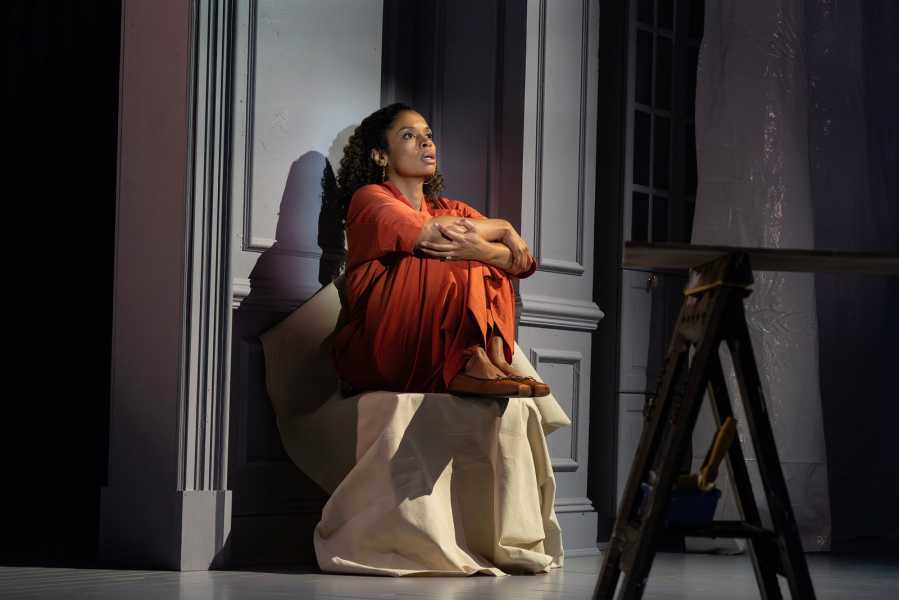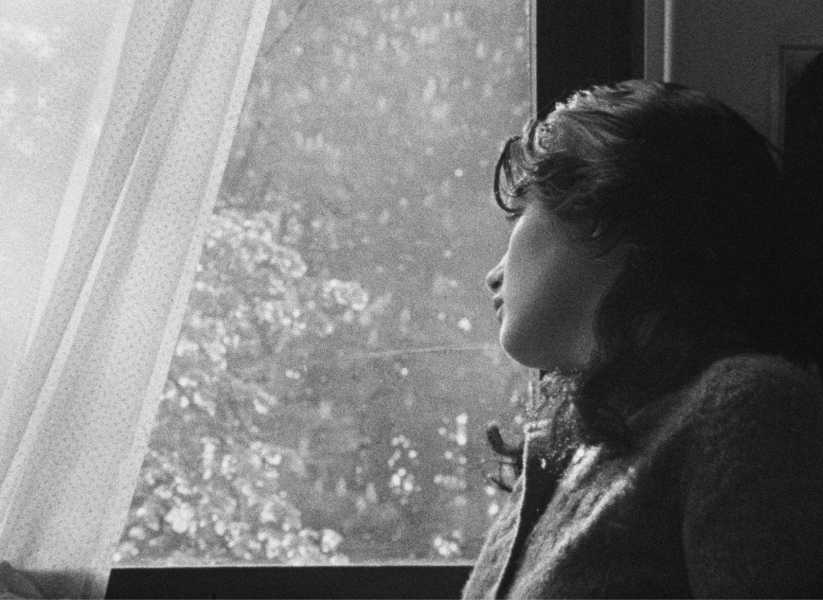
Save this storySave this storySave this storySave this story
Jackson Arn
Art critic
You’re reading the Goings On newsletter, a guide to what we’re watching, listening to, and doing this week. Sign up to receive it in your in-box.

“Shanty Town Gym Club,” 2023.Art work by Vernando Reuben / Courtesy the artist
Two hundred years ago, Brooklyn’s population was somewhere around ten thousand, double what it had been a generation earlier but still not enough to sell out a show at Barclays Center. The Brooklyn Bridge didn’t exist. Nor did BAM, Prospect Park, Grand Army Plaza, or the Coney Island Cyclone. In a winter landscape painted by Francis Guy around this time, the territory has more in common with a medieval village than with the place it’s about to become.
The Brooklyn Museum, where that art work and around a hundred and forty thousand others now reside, is one of the few institutions to have survived Brooklyn’s journey from village to metropolis. Today, it is a lovely Frankenstein’s monster of different eras and aesthetics, but in 1824 it was a newly incorporated public library, the first free, circulating one that the borough ever had. Its earliest art exhibitions date back to the eighteen-forties, though the west wing, designed by McKim, Mead & White, wasn’t finished until 1897, less than a year before the formation of the modern City of New York. In 2004, the main entrance was replaced with a shiny glass-and-metal lobby that, today, gushes out from the Beaux-Arts slab above it like cream cheese from a bagel.
This month, the Brooklyn Museum celebrates its bicentennial with “The Brooklyn Artists Exhibition” (through Jan. 26), a group show featuring the installations, drawings, paintings, sculptures, videos, and collages of some two hundred artists. The selection committee, which includes the likes of Mickalene Thomas and Jeffrey Gibson, has kept its criteria nicely indifferent to credentials: you must have lived or maintained a studio in Brooklyn at some time in the past five years, and you must be good. I wasn’t familiar with the work of Rodney Ewing, but now that I’ve had the sinister pleasure of “Bad Blood,” I will be looking for more. Here’s to him, and many others, and to the institution giving them a boost.

About Town
Broadway
In “McNeal,” Ayad Akhtar’s nerveless new drama about a morally suspect author, the titular character (Robert Downey, Jr.) uses ChatGPT to generate a novel. It’s an interesting premise, but McNeal, mixing booze with medication, seems to be suffering hallucinations, a dramaturgical dodge that permits a kind of arid, reality-be-damned unbelievability. McNeal wins a Nobel Prize, derides his own sexually abused son—a plot point that’s batted around as idly as a cat toy—and asks a Times reporter if she’s a diversity hire. She then describes him, approvingly, as “ruthless with the truth.” C’mon. Such glib slackness is occasionally counterbalanced by tension in the director Bartlett Sher’s production: the set glows with Jake Barton’s iPhone-on-acid projections, and Downey, an opaque presence, manifests a watchful, syncopated rigidity.—Helen Shaw (Lincoln Center Theatre; through Nov. 24.)
Dance
The British hip-hop company Far from the Norm, led by Botis Seva, made its name with “BLKDOG,” a dark and imagistic work that disturbingly mingles associations of childhood with intimations of violence and abuse. Now the troupe makes its U.S. début with that piece, which resembles flashes in the mind of a patient during a therapy session, with buried trauma fitfully surfacing. The movement vocabulary—rooted in popping, locking, and krump—expands into novel images, clear in form but ambiguous in meaning and emotional impact. The dancers, shuddering and collapsing and beetling around, might be children, or a child’s worst nightmare.—Brian Seibert (Joyce Theatre; Oct. 9-13.)
Off Broadway

Susan Kelechi Watson, as Aisha.Photograph by Joan Marcus
James Ijames has three genres in mind for “Good Bones,” directed by Saheem Ali. First, it’s a haunted-house thriller: Aisha (Susan Kelechi Watson) walks around her new home—a restored manse shrouded in construction plastic—disturbed by unearthly laughter. Second, it’s a relationship drama: Aisha flirts with her contractor, Earl (Khris Davis), and quarrels with her wealthy husband, Travis (Mamoudou Athie). Last, it’s a play of ideas, in which Earl and Aisha argue about gentrification. Strangely, Ijames toggles among genres, rather than blending them, so a revelation in one mode (Aisha desires Earl, say) has no impact on the next. The handsome set, designed by Maruti Evans, cannot disguise the fact that significant renovation is still necessary.—H.S. (Public Theatre; through Oct. 27.)
Classical
For Mahler, to write a symphony was to “construct a world.” His Third Symphony, the longest of nine completed, is not only its own world but an examination of creation itself. The piece flirts with themes of nature—bacchanalian horns, rumbles of summer thunder, floral harp flourishes—but extends past the physical. Existential questions resound with a setting from Nietzsche’s “Thus Spoke Zarathustra” and musings on angels, love, and the cyclicality of life. The Philadelphia Orchestra returns to Carnegie for this meta masterpiece. Yannick Nézet-Séguin conducts, with vocals from the mezzo-soprano Joyce DiDonato and members of three Philadelphian choirs: the Girls Choir, the Boys Choir, and the Symphonic Choir. Audience members will sit, without intermission, for more than an hour and a half. It’ll likely still feel too short.—Jane Bua (Carnegie Hall; Oct. 15.)
Movies

Photograph courtesy Icarus Films / OVID
The letter in the title of Charles Belmont and Marielle Issartel’s 1973 documentary, “Stories of A,” stands for avortement, the French word for abortion, which was then illegal in France. The film—which was then also banned in France—is an exploration of activism on behalf of the procedure’s legalization. Clandestine groups of medical volunteers performed abortions nonetheless, and some worked with the filmmakers to publicize their activities—as in a scene of a woman receiving an abortion in an apartment. Belmont and Issartel interview women who were planning to terminate pregnancies or were unable to do so, and film contentious meetings in which activists debate strategies. Above all, the filmmakers put abortion into the wider context of social and economic change—of women’s control over not just their bodies but their lives.—Richard Brody (Streaming on OVID.tv.)
Soul
In the late nineties, the Philly vocalist Bilal was pulled into the orbit of the neo-soul collective the Soulquarians, leaving the New School’s jazz conservatory to pursue a major-label career under the stewardship of Spin Doctors’ Aaron Comess. Bilal’s début LP, “1st Born Second” (2001), an overlooked classic in modern R. & B., bridged hip-hop and blues with assists from Dr. Dre, J Dilla, and Raphael Saadiq; its equally hyped follow-up, the funk-fusionist fever dream “Love for Sale,” didn’t have a proper release, but leaked to a cult following in 2006. Ever the experimentalist, the singer has remained a groundbreaker in the margins, and his atmospheric new album, “Adjust Brightness,” his first in eight years, once again puts his nasally yowl at the forefront of soul music’s endless expansion.—Sheldon Pearce (Music Hall of Williamsburg; Oct. 10.)

Bar Tab
Rachel Syme lounges around a new piano bar.

Illustration by Claire Merchlinsky
The best thing a piano bar can be is well worn. The room should feel creaky, sticky with spilled vodka stingers; the walls should thrum with the ghosts of chanteuses past. Still, someone has to open new cabaret clubs if we are to ever have old ones, and the owners of So & So’s, tucked behind a plain blue door on West Fifty-second Street—with an additional entrance in the Romer hotel lobby—have done just that. The room was designed as a spot for “show people” to gather, to listen to and belt out tunes; it’s a little bit 54 Below, a little bit Marie’s Crisis, a little bit cheesy cruise-ship bar. (The venue books Broadway performers and jazz trios to keep the keys tinkling.) The look is seventies louche, with velvet banquettes and swirly carpeting, the drink menu eccentric. (One twist on a Martini features blood-red beet juice.) The cocktail list was created by Phil Collins, a former backup dancer for Rihanna and Lady Gaga who is now charging ahead with a second career in mixology; one standout drink is the Bodega Cat, an opaque tequila concoction made with coconut milk, cherry, and cinnamon which comes in a classic “We Are Happy to Serve You” coffee cup. It’s gimmicky and oversweet, but it does conjure olde Manhattan. When I visited, one recent Friday night, an affable lounge singer, Jacob Khalil, plunked out sunny pop covers—“. . . Baby One More Time,” “Wonderwall”—on an upright piano. A woman called out for a song about the city; she had moved “upstate” to Westchester, she said, and was feeling homesick. Khalil launched into Billy Joel’s “New York State of Mind,” and, perhaps despite themselves, everyone sang along, becoming, at least for a song, old friends in a new place.
P.S. Good stuff on the Internet:
- Selena Gomez interviews Mariska Hargitay
- The world’s favorite raccoon
- Sally Rooney’s hungry characters
An earlier version of this article misstated a detail of the 2004 renovation to the Brooklyn Museum’s main lobby entrance.
Sourse: newyorker.com






